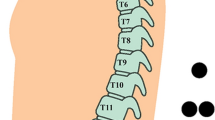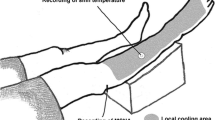Abstract
Skin blood flow (SKBF) was evaluated during arm-cranking exercise in able-bodied control subjects (AB; n=6) and in individuals with low- (LP; T10–T12 lesions; n=6) and high-level paraplegia (HP; T5–T9 lesions; n=6), using laser Doppler flowmetry (LDF). During moderate exercise SKBF decreased to [mean (SD)] 82 (15)% of the pre-exercise resting level in AB, whereas it increased to 158 (52)% in LP and to 112 (51)% in HP (the LP:AB difference, P < 0.05). During intense exercise SKBF increased to 366 (180)% of the resting level in AB, whereas it increased only moderately [147 (68)%] in both paraplegic groups (the paraplegic:AB difference, P < 0.05). The paraplegics developed a higher esophageal and leg skin temperature, which was attributed to the lack of active vasodilation and evaporative cooling over the legs. The results indicate that individuals with paraplegia suffer from impaired cutaneous vasoconstriction at the onset of arm exercise, and possess only a limited vasodilatory capability in the paralyzed regions. During intense exercise, thermoregulation depends critically on active cutaneous vasodilation and skin cooling.
Similar content being viewed by others
Author information
Authors and Affiliations
Additional information
Accepted: 25 August 2000
Rights and permissions
About this article
Cite this article
Theisen, D., Vanlandewijk, Y., Sturbois, X. et al. Cutaneous vasomotor adjustments during arm-cranking in individuals with paraplegia. Eur J Appl Physiol 83, 539–544 (2000). https://doi.org/10.1007/s004210000319
Issue Date:
DOI: https://doi.org/10.1007/s004210000319




